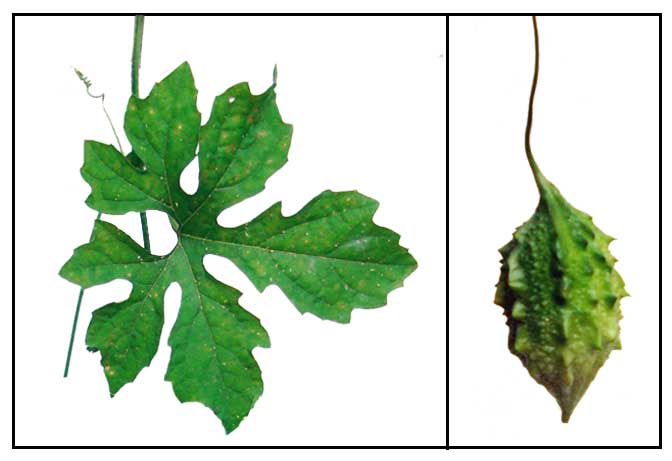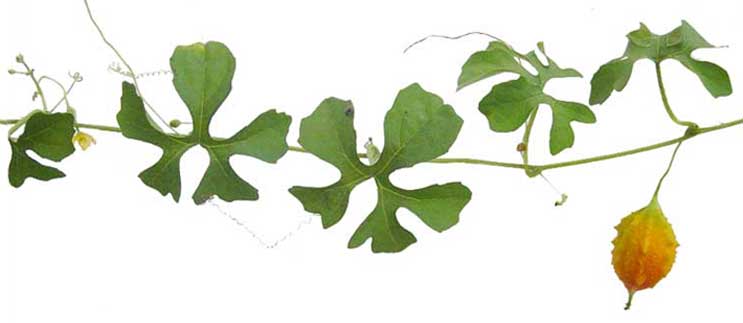|

Gen info
- Wild bitter gourd (WBG) shares with cultivated bitter gourd (Ampalaya / Momordica charantia) many or most of its properties. Some studies have shown wild bitter gourd has more potent anti-inflammatory activities and more potent disease prevention than cultivated bitter gourd.
Botany
Ampalayang-ligaw is a climbing vine with tendrils up
to 10 centimeters long. Leaves heart-shaped, 5 to 10 centimeters in
diameter, cut into 5 to 6 lobes. Flowers are yellow, about 10 millimeters long. Fruits are ovoid, about 2 to 4 centimeters long,
fleshy green, ribbed, with pointed ends.
Distribution
- Native to the Philippines.
-
Grows wild year-round in open fields, thickets, and waste places, at
low and medium altitudes.
Constituents
- Wild bitter gourd (WBG) is known to yield alkaloids, steroidal glucosides, phenolics, lysophosphatidyl-cholines, conjugated linolenic acid isomers, and cucurbitane-type triterpenoids.
- Water extract of wild bitter gourd fruit yielded phenolic compounds, flavonoids, and triterpenoids. There was an absence of saponin, alkaloids, and steroids. Triterpenoid compounds in the water extract of fruits were momordicoside L, momordicoside K, compound 3ß, ß7, 25-trihydroxycucurbita-5.23(E)-diena-19-al:R1=H, R2=H and momordicine 1. (8)
- Phytochemical screening yielded alkaloids, flavonoids, saponins, steroids, glycosides, and tannins with the absence of phenols and steroids. (see study below)
- Study of fruits of Momordica charantia var. abbreviata. isolated two new 27-norcucurbitane triterpenoids, 27-nor-3β-hydroxy-7β-methoxycucurbita-5,23(E)-dien-25-one (1) and 27-nor-3β-hydroxy-5β,19-epoxycucurbita- 6,23(E)-dien-25-one (2), together with two known cucurbitane triterpenes, 23(E)-7β-methoxycucurbita-5,23,25-trien-3β-ol (3) and 5β,19-epoxy-25- methoxycucurbita-6,23(E)-dien-3β-ol (4). (20)
Properties
- Studies have shown antioxidant, anti-inflammatory, hypolipidemic, hypoglycemic, anti-tumor, antimelanogenic, anti-adipogenic properties.
Parts utilized
Leaves, fruit, roots, stems.

Uses
Edibility
- Both wild and cultivated forms are edible.
- Fruit of wild form usually roasted over fire and eaten with salt or "heko."
-
Young leaves and fruit are edible. The
young leaves are preferred to the cultivated variety for use in soups
and other culinary inclusions.
Folkloric
- Juice of young leaves used for infants
and adults as mucolytic in tight and poorly productive coughs.
- Wild variety shares in the folkloric medicinal uses of the cultivated variety. (Ampalaya)
Toxicity
- None known.
 Studies Studies
• Comparative Study / Hypoglycemic and Hypolipidemic Activities / Wild and Hybrid Varieties: Study evaluated the hypoglycemic and hypolipidemic effect of Momordica charantia (wild and hybrid variety) powder on alloxan induced T2DM in Long-Evans rats. The wild variety showed more significant (p<0.05, 0.01, 0.001) effect on blood glucose level compared with the hybrid variety and standard drug (glibenclamide, 5 mg/kg). The wild variety also showed more significant increase in serum insulin level (p<0.05, 0.01, 0.001) than glibenclamide and control hybrid group. Results prove the wild variety of M. charantia fruit have potent antidiabetic and antilipidemic property. (1)
• Antioxidant / Cytoprotective / Anti-melanogenic / Leaves: Study investigated methanolic leaf extracts of a wild variety and two cultivars of wild bitter melon (WBM) developed in Taiwan. All extracts showed potent nitric oxide and hydroxyl radical scavenging capacities, reduced the production of ROS and prevented cell death in UVB-irradiated HaCaT keratinocytes. Also, all extracts significantly suppressed tyrosinase activity and melanin levels in B16-F10 melanocytes. Results showed antioxidant, cyto-protective and anti-melanogenic activities suggesting potential for preventing photo-oxidative damage and melanogenesis of skin. (2)
• Anti-Inflammatory / Hypolipidemic: Study investigated the influence of adding wild bitter gourd to diets on inflammation responses in mice with sepsis induced by intraperitoneal injection of LPS. Results showed wild bitter gourd in diets promoted lipid metabolism, reduced fat accumulation, and improved low blood glucose in sepsis. The addition of wild bitter gourd can reduce inflammation biochemical markers of indicators and pro-inflammatory cytokines, hence improving inflammatory responses in mice with sepsis. (3)
• Triterpenoid / Inhibits Breast Cancer Cells: Study investigated the antitumor activity of 3β,7β,25-trihydroxycucurbita-5,23(E)-dien-19-al (TCD), a triterpenoid isolated from wild bitter gourd, in breast cancer cells. TCD suppressed the proliferation of MCF-7 and MDA-MB-231 breast cancer cells with IC50 at 72 hours of 19 and 23 µM, respectively, via a PPARy-independent manner. TCD also induced cell apoptosis along with pleiotrophic biological modulations. Findings suggest the translational value of TCD and WBG as an antitumor agent in patients with breast cancer. (4)
• Anti-Inflammatory: Study on anti-inflammatory effect of WBG on lipopolysaccharide (LPS)-stimulated RAW 264.7 macrophages showed WBG is beneficial for reducing LPS-induced inflammatory responses by modulating NF-kB activation. Extracts of normal bitter gourd showed lesser inhibition on LPS-induced events. The phenolic compound elements paralleled its anti-inflammatory ability. (5) (6)
• Antioxidant: Study evaluated the antioxidant and free radical scavenging activities of aqueous and ethanol extracts of wild variety of BM using DPPH, metal chelation, cytochrome C and xanthine oxidase inhibition (XO) assays among others. The BM extracts showed potent antioxidant and free radical scavenging activities. (7)
• Cerasee, Wild Variety / Hypoglycemic: Study evaluated cerasee, a wild variety of M. charantia in the West Indies and Central America. Results showed hypoglycemic effect without significantly altering plasma insulin concentrations, suggesting cerasee may exert an extrapancreatic effect to promote glucose disposal. (9)
• Anti-Inflammatory Response in Mice with Sepsis: Study evaluated the influence of eating wild bitter gourd on inflammation response in mice with sepsis. Wild bitter gourd in diets promoted lipid metabolism, improved low blood glucose in sepsis, and attenuated inflammatory stress. Secretion of spleen pro-inflammatory cytokines were significantly lower. Expression of proteins NF-kB, iNOS, and COX-2 were significantly inhibited. Results suggest potential medical benefits for use of the plant food by certain persons. (10)
• Improves Metabolic Syndrome / Preliminary Dietary Supplementation Trial: Wild bitter gourd (WBG) has ameliorated metabolic syndrome (MetS) in animal models. Study evaluated the effect of WBG supplementation on MetS in Taiwanese adults. Results demonstrated the beneficial effects of WBG on metabolic syndrome in humans. A daily dose of 4.8 g lyophilized WBG powder significantly decreased the MetS incidence rate after three months of supplementation. Waist circumference also significantly decreased after WBG supplementation. No adverse effects were observed. (11)
• Benefits of Roasting Bitter Gourd / Increased Antioxidant Activity: Study evaluated the effect of roasting bitter melon fruits, leaves, stems, and roots on antioxidant activity using DPPH, ABTS, reducing power, and FRAP assays. The roasted bitter melon exhibited significantly higher antioxidant activity than unroasted BM in the test methods used. Roasted roots showed higher antioxidant activity than other extracts. Antioxidant compounds including flavan-3-ols and phenolic acids increased, while flavanols decreased following the roast processing. (12)
• Antioxidant Activity: The scavenging activities against DPPH and hydroxyl radicals were different among MCA cultivars. For inhibitory activities against Cu2+-induced low-density lipoprotein peroxidation, most MCA cultivars at 4000 µg/ml showed protective activities and were equivalent to 0.8 mM Trolox thy thiobarbituric acid reactive substance assays. (13)
• Hypoglycemic / Semipurified Peptides: Study investigated the hypoglycemic effect of semipurified peptides of an aqueous extract of M. charantia var. abbreviata in alloxan-induced diabetic mice. MC2-1, a semipurified peptide fraction produced significant hypoglycemic effect. It also markedly increased HDL cholesterol and serum insulin levels. Results suggest potential for incorporation as supplement in health-care products and/or combined with hypoglycemic drugs. (14)
• Anti-Inflammatory / Inhibition of Lipoxygenase Enzyme: Study showed in vitro anti-inflammatory activity by inhibition of lipoxygenase (LOX) enzymes and attributed the anti-inflammatory activity to non-protein components. (see constituents above) (15)
• Antibacterial / Cytotoxic / Fruits: Fresh fruits of wild bitter gourd, cultivated bitter gourd and methanolic extracts of 16 cultivars were evaluated for antibacterial activities toward methicillin-resistant S. aureus, P. aeruginosa, E. coli, and Salmonella enterica subsp. enterica and their cytotoxic activities toward human fibrosarcoma HT 1080 cells. None of the extracts showed inhibitory activity against MRSA or P. aeruginosa. Several showed activity against growth of E. coli and S. enterica. Some extracts showed cytotoxic activities toward human fibrosarcoma HT 1080 cells. (18)
• Biologic Activities: Study evaluated the biologic activities of extract and fractions of wild bitter melon. The ethyl acetate fraction exhibited high DPPH radical scavenging activity with IC50 of 0.43 mg/mL. The EA and n-butanol fractions exhibited highest protective effect against H2O2-induced DNA damage in a concentration-dependent manner. The EA fraction inhibited α-amylase activity with IC50 of -0.27 mg/mL. The production of nitric oxide (NO), a pro-inflammatory mediator, was significantly reduced from LPS-stimulated murine macrophage RAW 264.7 cells by ethanol extract and EA fraction. Results suggest a promising biomaterial for the development of pharmaceutical products. (19)
• Biologic Activities and Phenolic Profile / Aerial Parts: Study evaluated the biological activities of ethanol/water extract of aerial parts and presence of phenolic compounds. The extract exhibited antioxidant activity in four assays (DPPH, reducing power, ß-carotene bleaching, and TBARS). Key roles of oxidative stress in inflammation and tumorigenesis was supported by results of anti-inflammatory (inhibition of NO production) and cytotoxicity (human tumor cell lines: HeLa, HepG2, MCF-7, and NCI-H460) assays. No toxicity was seen in nontumor cells. On antibacterial screening, clinical isolates were significantly affected, with Listeria monocytogenes the most susceptible. Three phenolic acids and 11 flavonol glycoside derivatives were identified, with quercetin-3-O-pentosylhexoside being the most abundant. (21)
• Anti-Adipogenic Activities: Study isolated two chlorophyll-degraded compounds, pheophorbide α (1) and pyropheophorbide α (2) from wild bitter gourd ethyl acetate fraction of methanol extract. Treatment with compounds 1 and 2 showed dose-dependent reduction in lipid accumulations and reduced nuclear DAPI stains in differentiated 3T3-L1 adipocytes. The compounds were more toxic to differentiating adipocytes than to non-differentiated pre-adipocytes, which partly resulted i anti-adipogenic activities with lowered lipid accumulation. (22)
• Anti-Inflammatory / Suppression of Propionibacterium acnes-Induced Inflammation / Fruit: Study evaluated the inhibitory effect of wild bitter melons on Propionibacterium acnes-induced inflammation. In vitro, the ethyl acetate extract of fruit potently suppressed pro-inflammatory cytokine and matrix metallo-proteinase (MMP)-9 levels in P. acnes-stimulated THP-1 cells. In mice, intradermal injection of EA extract effectively attenuated P. acnes-induced ear swelling and granulomatous inflammation. Results suggested that PPARα or PPARγ signaling may contribute, at least in part, to the anti-inflammatory activity of wild bitter melon. (23)
• Anti-Inflammatory / Upregulating Injury-Attenuated CISD2 Expression in Spinal Cord Injury: Spinal cord injuries (SCIs) induced secondary neuroinflammation through astrocyte reactivation, which affects neuronal survival and causes long-term disability. CDGSH iron sulfur domain 2 (CISD2), reported to be involved in mediating the anti-inflammatory responses, can be a target in SCI therapy. WBM mitigated the SCI-induced downregulation of CISD2, PPAR-ß, and IkB and upregulation of glial fibrillary acidic protein in the spinal cord of SCI mice. SH-SY5Y neural cells with CISD2 knockdown exhibited decreased PPAR-ß expression and augmented NF-kB signaling. Study suggests that wild bitter melon can mitigate the injury-induced downregulation of CISD2 in SCI mice and LPS-stimulated ALT astrocytes. (24)
• Also read studies on Ampalaya
Availability
- Wild-crafted.
- Tablets, capsules, extracts in the cybermarket.
|




 Studies
Studies 

